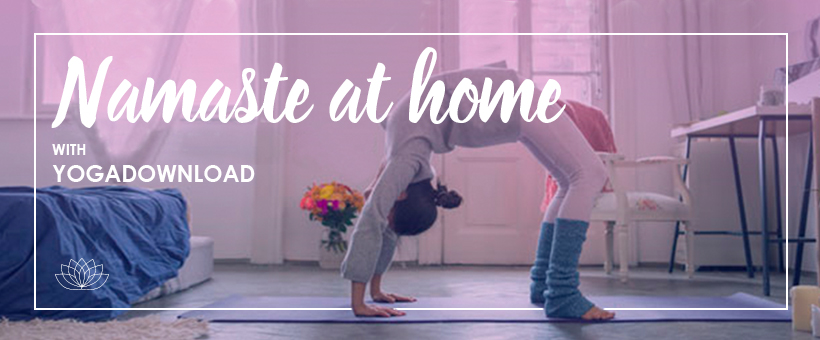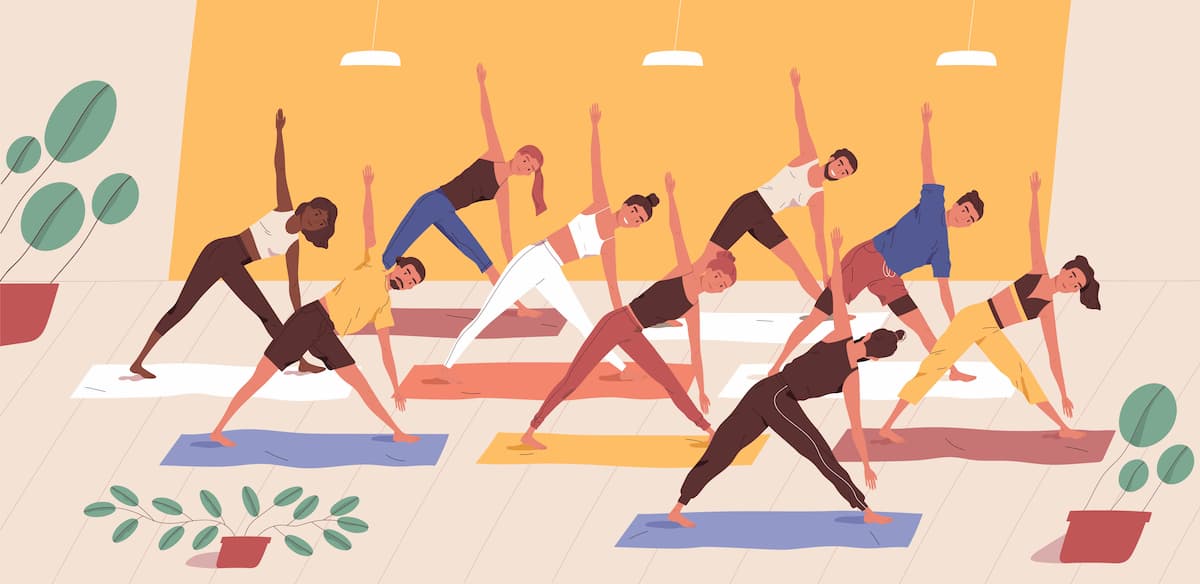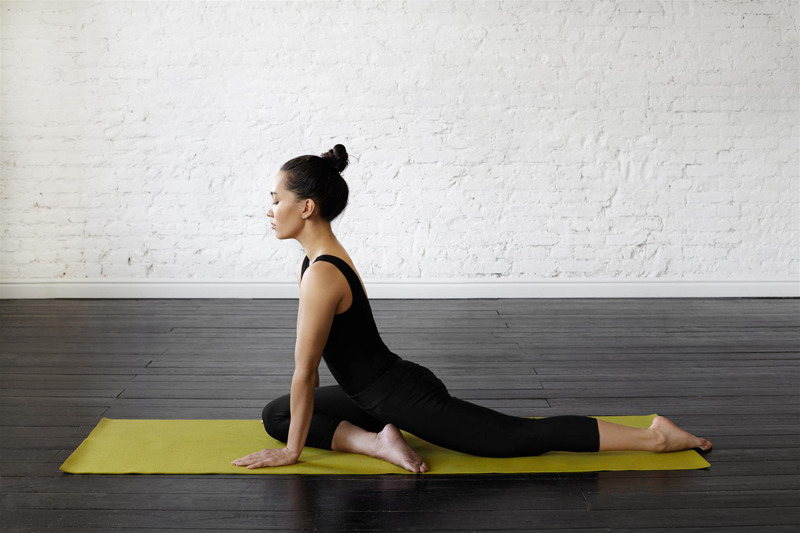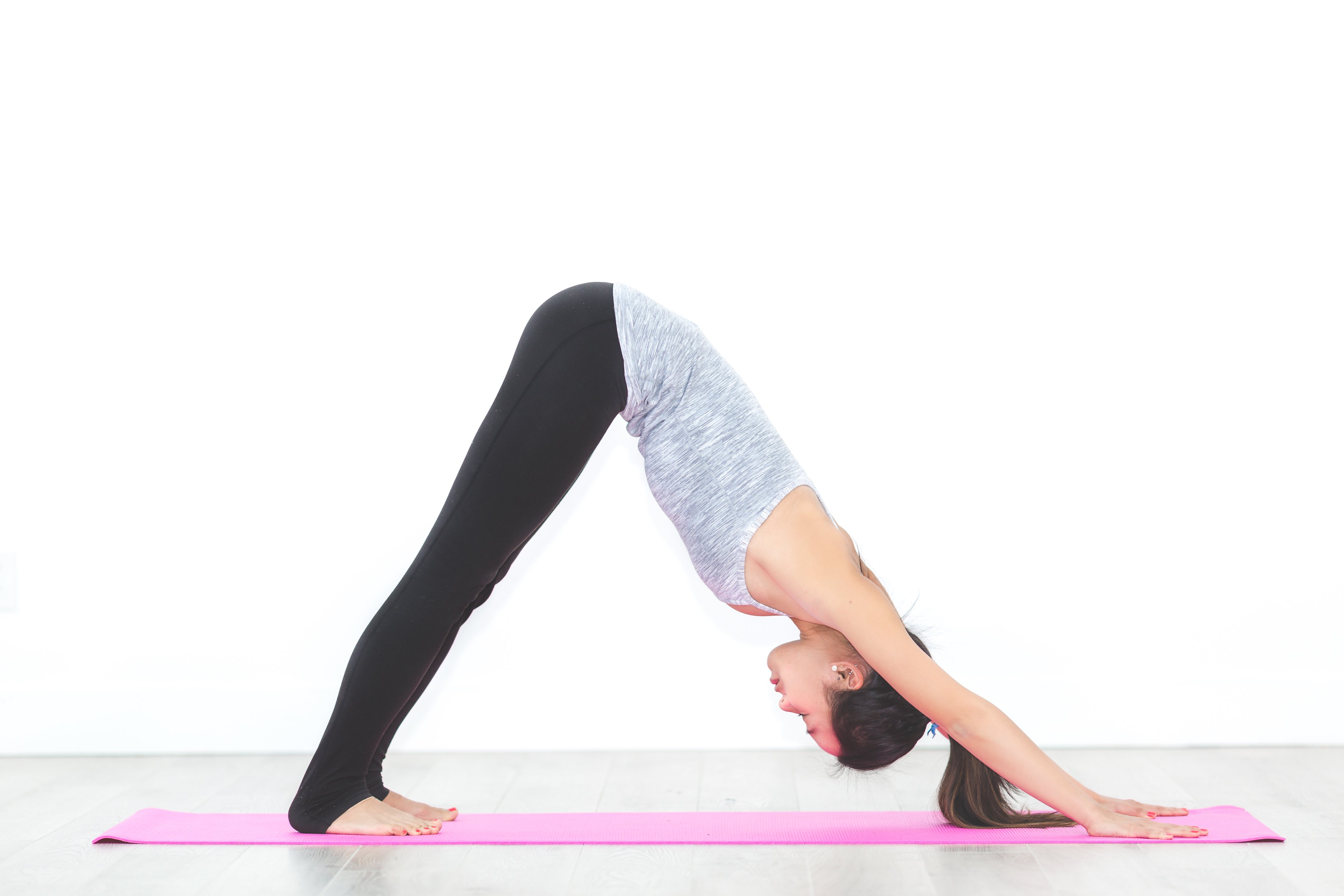Beginner yoga guide
Unless you've spent the last ten years in a cave, you couldn't help but hear about yoga.
If the ancestral discipline has been a bit overturned by being taken over by Instagram and becoming a multi-million dollar business, it is still a beneficial practice for body and mind. But is it right for you and what is it really about? That's what I'm going to try to answer right now!
THE ORIGIN OF YOGA
One must understand that before being a fashionable hashtag on social networks and an image of colorful leggings, yoga is above all a very broad term that relates to the spirituality and religion of ancient India. In Indian and Hindu philosophy, the cycle of rebirth continues as long as a living being does not reach a level of perfection, it is only at the end of it that the being can finally experience liberation.
In the continuity of this thought, yoga was elaborated so that the human being is able to detach himself from the material aspect of things, too often a source of useless suffering according to the sages. It is only through this good that the being can reach enlightenment, and thanks to a set of techniques combining physical and mental exercises (understand, meditation).
Yoga thus has a whole meditative dimension, physical and mental, which requires mental discipline, balance, flexibility and strength. In fact, beyond a sporting discipline, yoga is truly an art of living whose members often share the same values.
Yoga really became popular in the few decades following the manufacture of the first yoga mats in the 1980s. As a result, many people see yoga as a simple physical stretching and strengthening routine. The first mentions of yoga can be found in the Vedas, very old Indian writings dating back to 1500 BC!
It goes without saying that at that time, yoga was not at all reminiscent of a one-hour class given by an instructor who made sure that his students respected both their breaths and their alignments. It is said that the first asanas (yogic poses) came from sacrificial ceremonies conducted by Vedic priests.
It was only later, under the guidance of Hinduism and Buddhism that Yoga came to represent more meditative and spiritual practices. Over time, it evolved into the yoga we know and appreciate today in the West, focusing primarily on physical movement and alignment with the breath.
Modern conceptions of yoga generally consist of 8 pillars that define the noble eightfold path:
- Yama: integrity, honesty and non-violence (the reason most yogis become vegetarians).
- Niyama: self-discipline of body and mind.
- Asana: Yogic postures.
- Pranayama: breathing.
- Pratyahara: introspection away from the senses.
- Dharana: a practice that opens the way to meditation.
- Dhyana : meditation.
- Samadhi : the final state of bliss and ecstasy that one experiences once the previous 7 pillars have been mastered.
Notice that our way of seeing Yoga in the West is finally 1/8 of what Yoga really is!
All this is not to tell you that yoga postures don't matter, no, but simply that the benefits of yoga also make their way through the mind (and through a regular practice of asanas).
Let's talk about the benefits of yoga !

THE BENEFITS OF YOGA
If you are a passionate yogist, the benefits of yoga have probably not escaped you, perhaps you sleep better or feel more comfortable in your everyday life, more Zen in the face of stressful situations.
Maybe the benefits you feel are physical, and the practice of yoga allows you to counterbalance the long hours you spend sitting at your desk every day, or bring relief to problems such as osteoarthritis.
But if you've ever tried to explain to a newcomer all the virtues of yoga, you've probably had to deal with a few skeptics, go explain to someone who knows nothing about it that practicing this gentle gym "increases the flow of energy" or "transmits this energy to your spine"...not easy!
The fact is that the benefits are vast! As with any physical activity, the benefits of yoga will only be reaped through regular practice, like meditation, 15 minutes daily is better than 2 hours every 2 weeks. Going to a class once a week is good, but it may not be enough.
• Improves overall health : Yoga can both prevent illness and promote recovery, but that's far from all...
• Increases concentration : An important component of yoga is to focus on the present. Studies have shown that regular yoga practice improves coordination, reaction time, memory and even IQ scores.
• A more serene spirit: Yoga removes the fluctuations of the mind, in other words, it slows down the mental loops of frustration, regret, anger, fear and desires that can cause stress.
• Improves sleep : Yoga can relieve the restlessness and overwork caused by modern life. Nidra yoga, a form of guided relaxation, provides a break for the nervous system, which means you will be less tired and less stressed.
• Assists in weight loss : The adage says eat less move more, and yoga can help on both fronts. Regular practice will help you burn calories, and the spiritual and emotional dimensions of your practice can solve your eating problems on a deeper level...
• Strengthens bones : Resistance exercises help strengthen bones and help prevent osteoporosis, yet many yoga postures require you to lift your own weight.
• Increases flexibility : Improving your flexibility is one of the first benefits you will enjoy, during your first class you probably won't be able to touch your toes, but little by little you will notice a progressive slackening...there's nothing magic about that!
• Improves blood pressure : Yoga and relaxation exercises can help to thin your blood, especially in the direction of your hands and feet. Yoga also helps to better oxygenate the cells through torsion exercises.

THE DIFFERENT TYPES OF YOGA
There are many forms of yoga, some focus on breathing, others focus on deep stretching. Beyond the content, each type of yoga has a different intensity, some will really make you sweat!
In any case, all yoga classes share certain common sequences, such as the traditional Savasana at the end of the session, a break in time that consists of relaxing, lying on your back for several minutes, breathing deeply.
Regardless of the type of yoga practiced, you can also be sure that your instructor will monitor the alignment of your body and the synchronization of breathing through the different asanas.
You may well have to try several styles of yoga before finding the one that suits you best. The mistake would be to make a hasty judgment after a class or two, the fact is that there is something for everyone and from one instructor to another, the content of a class can change drastically.
However, here is an overview of the different practices:
- Hatha Yoga : excellent introduction to yoga for beginners, he will teach you the most known postures in a generally slow pace.
- Ashtanga Yoga: usually begins with greetings to the sun, then follows a series of standing postures and ends on the ground. There are classes for beginners and advanced. Ashtanga is perfect for waking up your body in the morning with its vigorous sun salutations, stretching and opening of the spine. Once you have memorized the sequence, you will be surprised how quickly your body gets used to the poses, this routine has something therapeutic about it ...
- Vinyana Yoga: Also known as "flow", Vinyasa is an adaptation of Ashtanga, so the two styles are quite similar, including the sun salutation. The rhythm is fluid and follows the breath. The training is quite rigorous!
- Bikram Yoga: do you enjoy doing yoga in a deliberately hot atmosphere (40° and 40% humidity)? Hot yoga would be particularly good because of its detoxifying nature by pushing you to sweat! The beginnings will be very hard, but your body will quickly adapt. If you don't like to sweat, go ahead.
- Power Yoga: a style that is not traditional for a penny, rather focused on strength and endurance. It's the choice for those looking for a workout that focuses on abdominal strap work.
- Iyengar Yoga: with its slow and meditative rhythm, it is not easy! Particular emphasis is placed on aligning the body during poses held for a long time, sometimes with the help of certain accessories (yoga brick, yoga cushion, etc.).
- Yin yoga: probably the best choice for beginners, with its slow rhythm and asanas held for long periods of time (30s to a few minutes). Here, we don't work on strength, but on flexibility. The experience is meant to be relaxing and meditative.
THE ROLE OF ASANAS
In ancient times in India, yogis had discovered that posture could have an influence on the deep state of a being. They firmly believed that nadis (small energy channels) ran through the body carrying an energy called "prana": the force of life. It was said that if these nadis were aligned, then the flow of prana was harmonious, contributing to good health. On the other hand, if the nadis were blocked, it was said that prana energy could accumulate in one point and create tension.
The goal of yoga is to rebalance these nadis and restore the body to its natural state. Yogis saw the body and mind as a whole that functions in continuity and influences each other. According to this philosophy, if the body is kept well aligned and energetically balanced, the mind also follows.
Then years of television, smartphones and ignorance plunged our bodies into very sad postures by throwing them off balance. Could the answer be to pay more attention to our posture? According to science, YES.
Studies show that simply sitting properly, properly aligned affects mood in such a way that we remember happy memories more than unhappy ones, in addition to building confidence. Sitting upright increases testosterone levels while decreasing cortisol (stress hormone) levels.
Certain postures (or asanas), would therefore have the "power" to benefit the organs...would it then be possible that the prana energy, when circulating well, could calm our distracted mind and energize our body?
Well, another facet of yoga is the work done on the breath. Did you know that we breathe an average of 23,000 times a day? Most of these breaths are shallow and often involve the intercostal muscles, especially under stress. They are quite pale in comparison to their counterparts, the diaphragmatic breaths known to yogis by the name "adham pranayama".
This type of deep breathing not only positively affects lung function or posture, it activates the nerve that triggers the parasympathetic relaxation response. Evidence that breathing and the nervous system are closely linked. Body and mind are inseparable, we tell you!

RATHER YOGA OR MEDITATION?
Rather body or mind? Maybe that's a question you're asking yourself? Let's try to analyze the advantages of each of the two ancient disciplines from a scientific point of view:
Yoga
- Benefits of Yoga : It is well known that Yoga slows down aging, relieves inflammation, insomnia and back pain.
- Makes you in a better mood : In just 3 months of regular yoga, your levels of brain-derived neurotrophic factor (a biomarker that is weaker in people with depression) will triple, boosting your mood in the long run.
- A decent way to lose weight : A restorative yoga class has been proven to help you lose more than 2.5 times the subcutaneous fat mass compared to standard stretching, according to the National Institutes of Health.
- Simply more Zen : Do your morning sun yoga routine with dogs upside down and you'll enjoy a two-fold drop in blood pressure, which says reduced vascular stress means reduced risk of heart disease.
Meditation
- Benefits of meditation : It is well known that meditation increases energy levels, improves memory, reduces the risk of cancer and cholesterol!
- Immediate effects : Studies show that it only takes one hour of meditation for a neophyte to observe the effects on anxiety reduction! Moreover, the beneficial effects on stress levels seem to last for a week!
- Dieting aid : Mindfulness meditation is the perfect addition to a weight loss goal. The University of Northern California found that those who meditated lost seven times more than those who did not!
- Better in Mind : Meditation has been shown to release nitric oxide, which opens blood vessels and lowers blood pressure. Mindfulness can reduce the risk of dying from a heart attack or stroke by almost a third!

PRACTICING YOGA AT HOME, POSSIBLE?
That's a big yes! And fortunately, when you see the price of some yoga studio memberships.
Doing yoga at home is no more difficult than unrolling your mat...on the square side, you will only need a few square meters of space, so what's your excuse?
Whether it's the first thing you do in the morning or the last thing you do in the evening, yoga can be very easily integrated into your daily routine. The question is how do you do it?!
Your to-do list for starting yoga at home:
1. Buy a yoga mat.
2. Find comfortable, breathable and stretchy clothing that won't restrict your movements. You must be perfectly comfortable in them, yoga leggings and crop tops/braces are generally preferred.
3. Choose a space (better yet, make your own) so that you can roll out your mat without being hindered by any furniture.
4. Find a beginner's class on YouTube or on a yoga application.

FAQ
Learning yoga on your own at home is good for your wallet and planning, but to get the most out of it, I still advise you to go to a few studio classes with a real trained teacher, especially if you are a beginner.
Even though your yoga application would explain the postures to you perfectly, it doesn't see you perform them, so it's hard for you to see if you're properly aligned. You may think that your back is straight in a plank/sheathing posture, while your back is rounding or your posture is sagging at the hips!
The yoga instructor will see this directly and will help you adjust your posture according to your flexibility and strength level, and make sure you are properly aligned so you don't hurt yourself.
Once you are familiar with asanas and are sure you are properly aligned, you can perfectly resume your practice at home and pursue your goals, with the peace of mind of knowing that you will not get hurt.
Generally it is said that it is good to have a small healthy snack (a smoothie, a homemade cereal bar, a few seeds, a banana, etc.) two hours before going to practice your yoga class (in the studio or at home), so that you don't have to worry about your digestion.
However, if you choose to do your yoga in the morning (which is what I recommend), it is better to have an empty stomach so as not to be hindered in your practice.
On the hydration side, drink regularly in small quantities, and not too much just before class, especially when it comes to Bikram yoga.
"There is no right or wrong time" one might say. Traditionally, yoga was practiced early in the morning and on a personal basis, this is the time I prefer, because sequences such as the sun salutation are ideal for waking up a sleeping body and the day is only better afterwards. However, the right time for you is the schedule that you are most likely to be regular in your practice. Note that late day/early evening yoga is also great for a good reason, you'll sleep like a baby afterwards!
As with any form of exercise, you will discover new muscles as you start yoga and may experience aches and pains after your first classes! You may shock your muscles with movements they are not used to and stretch them deeply. However, our body has a fantastic capacity to adapt, so you will be able to push your limits further each time and go for a stretch that is superior to the previous one. The advice is to do it gradually, with about 3 short 15-minute sessions per week and then increase.
"That depends!" Sorry, I hate that answer too, but the point is that you need to tailor your yoga practice to your goals. Are you looking to improve your flexibility? Do you want to strengthen your muscles? Are you recovering from an injury or just enjoying the many mental benefits of yoga? If you start in a class that is not designed for beginners, you may soon feel a little lost with all the fast postures, it won't be pleasant for you, you will fall behind and feel like you're doing everything wrong.
So find a slower pace class especially for beginners. Hatha Yoga is a great place to start as well as Iyengar. Then I'll tell you that the best way to find out which class is your favorite is to try them all. Most studios offer several styles with several certified instructors, so you may well fall in love with a class or a teacher (by that I mean his or her way of teaching). Why not give yourself a little taste by browsing YouTube as well? I have a few specific styles of yoga for you.
Can you lose weight with the practice of Yoga? The answer is yes, there is no reason not to lose a few pounds if your yoga practice is regular and you monitor your eating habits outside of class. That being said, the more physically engaging the yoga class is, the more calories you will burn, that goes without saying. In this little game, hot yoga, power yoga or the very trendy Hiit Yoga are your best allies!
Any style of yoga is good for a gentle awakening in the morning, you really can't go wrong at this level, as all classes include a good progressive warm-up and a cool-down sequence at the end of the session. You can control the intensity of your morning practice by the speed with which you will perform the asanas and the way you will breathe in parallel. I keep telling my friends that a few greetings in the sun with a deep breath is better for me than a coffee to wake me up! For this, I can only recommend the Ashtanga and Vinyasa classes, which are excellent choices for a great start to the morning.
Normally, all types of yoga will do the job. That being said, if your flexibility doesn't improve even though you're regular in your yoga practice, there's probably something wrong! Try holding the postures a little longer, taking long breaths and relaxing to feel deeply rooted in your poses. Just know your body's limits and don't overdo it.
It's normal to feel out of your comfort zone during some asanas (that's the goal), but if you start to feel real pain, stop. Any model of yoga that makes you hold postures a little longer such as Yin Yoga will be excellent for your flexibility. "I want to do yoga to reduce my back pain." Yoga is fantastic for helping with all kinds of low back pain, thanks to its lubricating effect on the spine, the stretching and back strengthening it provides.
Some yoga postures are particularly good for the back and can offer immediate relief, such as the cat and cow pose. The child's posture is also a good position for the back, offering a light stretch while being extremely relaxing. Overall, any posture that involves twisting the back can provide a gentle stretch for the spine that can relieve tension that has built up over the course of the day. It's not much of a risk to try a gentle form of yoga to treat your lower back pain.
Any yoga posture that involves resisting gravity in some way (i.e. you are not sitting or lying on the ground) will require strength. Simply holding the dog upside down for several breathing cycles will require upper body strength. Some postures are obviously more challenging than others, such as the board, the boat, the chair or the warrior.
Almost all yoga sequences recruit the abdominal strap. However, some poses specifically target the abdomen, I invite you to read my article on the best yoga poses to lose belly and work the abs. We will generally point out postures such as the boat pose or the famous abdominal board to target the abs.
WHAT EQUIPMENT TO DO YOGA?
If you are new to yoga, you don't need much. The beauty of yoga lies in its simplicity and minimalism, all you need is a piece of floor and a yoga mat, your best friend from now on.
Could you practice without a mat?
The ancient yogis did not wait for his invention to practice, but it must be said that yoga has changed a lot since then as well. In the past, yogis focused more on meditation and breath work than on asanas. In some traditions such as Ashtanga, yoga was traditionally practiced on mats, using animal skins or simply practicing yoga on the grass. However, the mat is still a must, which makes yoga much more comfortable (try holding a dog upside down without...). Seriously, if you're going to be serious about your yoga practice, you need a quality mat.
What are the best yoga mats?
Among the best brands are Lululemon or Manduka, but the final choice of your model will depend on your criteria. Everyone sees noon at his door. For my part, when I change yoga mats, I prefer brands that pay special attention to respect for the environment and ethics.
When it comes to buying a yoga mat, paying more for better quality is really worth it! A good yoga mat will last many years while maintaining its grip, cushioning and durability. Better quality yoga mats are also made of more environmentally friendly (and human friendly) and non-toxic materials.
Many stores carry cheaper brands (usually $10 or less) that simply don't have enough grip for a sustainable yoga practice, deteriorate quickly and are not made from "eco-friendly" materials. In my opinion this does not correspond to the values of yoga, but it's up to you.
Here are the criteria you should consider when purchasing your yoga mat:
- Good adhesion
- Durable materials
- Natural and non-toxic materials
- Good cushioning (minimum 4mm)
- Long enough for your size

SOME TIPS
Don't judge the practice of yoga after just one class, there is a type of yoga for everyone, from the most gentle to the most intense.
Just because your friend loves this or that type of yoga doesn't mean you will love it too, don't compare yourself to anyone else.
I really encourage you to go to several classes with several certified yoga instructors until you find the practice you are most comfortable with.
Beyond that, incorporate yoga into your lifestyle, read its teachings and apply them.
You will need to be patient, your body will likely experience happiness, but also frustration, pain and discomfort.
Be patient with your body and your mind, it's all part of the process, part of the journey.
We all started somewhere, be sure that once you are regular in your practice, you will soon no longer be a beginner.
Stop focusing on the destination, focus instead on the journey, it's much more rewarding.


